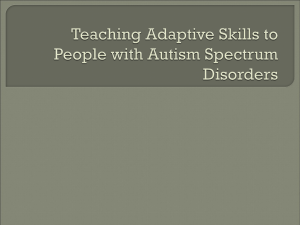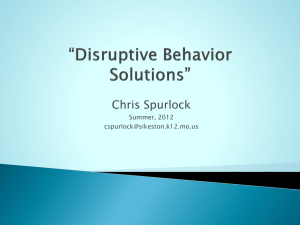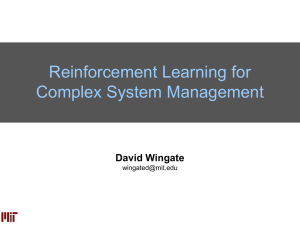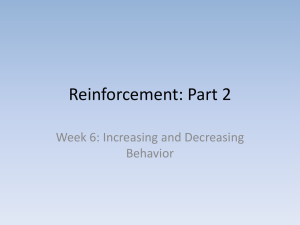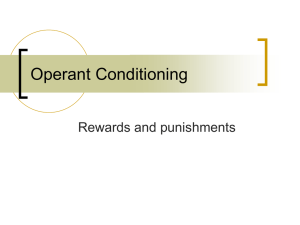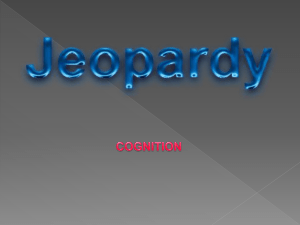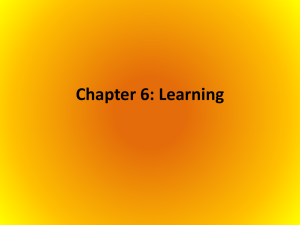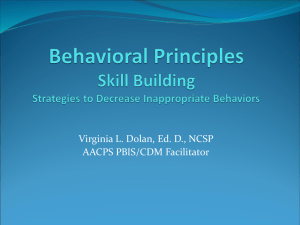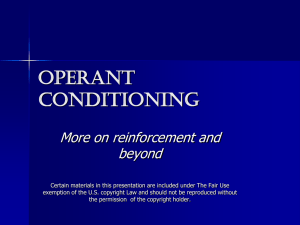Powerpoint® Systematic Instruction Plans - MAST
advertisement
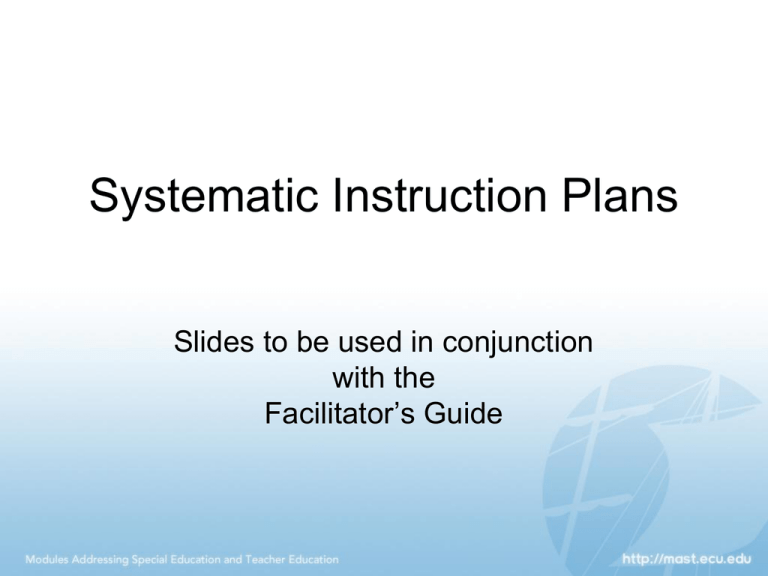
Systematic Instruction Plans Slides to be used in conjunction with the Facilitator’s Guide Copyright © 2012, East Carolina University. Recommended citation: Mims, P., & Henderson, K. (2012). Systematic instruction plans – A PowerPoint presentation for professional development. Modules Addressing Special Education and Teacher Education (MAST). Greenville, NC: East Carolina University. This resource includes contributions from the module developer and MAST Module Project colleagues Kelly Henderson (Facilitator Guide Editor), Tanner Jones (Web Designer), Diane Kester (Editor), Sue Byrd Steinweg (Project Director), Bradley Baggett (Graduate Assistant), and Sandra Hopfengardner Warren (Principal Investigator). Session Agenda • • • • • Introduction Session Goals and Objectives Background Writing Objectives Prompting Strategies Session Agenda, continued • • • • • Systematic Instruction Plans Fading Prompts Reinforcement Summary Evaluation Introduction Mr. Quartez realizes that a student is not making appropriate progress on a skill. After observing instruction on the skill with his two paraprofessionals and the occupational therapist, the teacher realizes that they are each using a different wait time between prompts and a different prompt hierarchy to teach a student to wash his hands. Introduction, continued His paraprofessional, Maria, is using the system of least prompts on each step of the task analysis with a prompt hierarchy of a verbal, model, and physical and a 3 second wait time. Sandy, the other paraprofessional, is using the system of least prompts too, but her hierarchy was a nonspecific verbal, specific verbal, and a model with a 4 second wait time Introduction, continued Finally, the occupational therapist Jimmy is using most to least prompts starting with a physical prompt, then a partial physical, then a model, and finally a verbal prompt. Introduction, continued The Problem: • Mr. Quartez needs to come up with a system so that everyone is using the same system for teaching each objective to each student. • This is a common problem in classrooms when teachers and other members of the team are teaching Individualized Education Program (IEP) goals and Alternate Assessment goals. Introduction, continued • It becomes hard to remember which prompting strategy is being used for which student and what wait times are set in place. • To resolve this, teachers need to write a systematic instruction plan (SIP) for each goal taught in the classroom. This will serve as a guide for all instructors to teach each skill the same way. Session Goal • This module will help the participant learn how to fill in the different parts of a systematic instruction plan (SIP). • Additionally, the module will include information regarding how to identify the reinforcement and error correction strategies as well as teaching for maintenance and generalization. Session Objectives Participants will be able to: 1. Identify the sections of a systematic instruction plan (SIP) and what to include in each section. 2. Identify the appropriate prompting strategy (response prompting or stimulus prompting) to be used with the skill chosen in the SIP. Session Objectives, continued 3. Select a plan to systematically fade out prompting strategy chosen. 4. Identify positive reinforcement vs. negative reinforcement, schedules of reinforcement, and methods to identify reinforcers. 5. Identify strategies for error correction procedures. Select a plan of maintenance and generalization based on a chosen skill. Background • Research indicates that systematic instruction has been successfully used to teach discrete skills, chained skills, functional skills, and academic skills to students with disabilities, but without consistent instruction across teachers, acquisition will not rapidly occur. Background, continued • The first step that teachers need to consider on the road to strong, consistent instruction is to write and to select observable and measureable objectives to teach. Let us take a look at some things to consider. Writing Objectives • When identifying the skill to be taught, first specify the IEP objective or objectives the student will be working on or the Alternate Assessment goals being targeted. • Then the objective should be written in measurable terms, meaning it can be observed and counted. Writing Objectives, continued • The objective is written so that the student can master it independently. • Prompts should not be written into the objective. Prompts are a teaching strategy that the teacher would use to systematically fade back to independence. Writing Objectives, continued • Consider the actual objective the student is being asked to do. – Is it something that they would ever be able to do independently? – For example, would the student ever be able to complete the objective without physical guidance? – If not, consider writing the objective for the student to complete the skill but using a different response mode. Writing Objectives, continued – So this objective: “During a shared story, Tonya will activate the voice output device to complete the repeated story line with hand over hand assistance in 3 out of 4 opportunities,” might be better written as – "During a shared story, Tonya will independently activate the voice output device using a head switch to complete the repeated storyline in 3 out of 4 opportunities." Writing Objectives, continued • In these examples, the students have to independently demonstrate what they know rather than receiving a prompt of some sort. • Using prompts during instruction is completely appropriate, but they need to be faded out when trying to identify mastery for a goal. Writing Objectives, continued • An objective must include: – a target behavior, – condition, and – criteria. • Each of the examples starts out with the condition (i.e., When presented targeted sight words, when presented with a writing utensil and a writing surface, given her phone number and two distracter numbers), Writing Objectives, continued • Followed by the target behavior (i.e., independently read, independently mark on paper, independently point to own phone number), and • Followed by the criteria (i.e., 4 out of 5 sight words, 4 out of 4 trials, 4 of 5 trials). Writing Objectives, continued • What is wrong with the way the tasks in the Non-Examples are written? • Two problems in the first example: – How can we measure “participate”? It would be necessary to operationally define participate so that it can be observed and measured. – The objective is written with physical assistance. Sherrie is passive in this objective. Sherrie could be asleep and still master this objective because the teacher would technically be allowed to guide her through the science lesson. Writing Objectives, continued • Problems in the second example: – It cannot be measured. Is the objective for Lynn to sit quietly during independent reading time or is the goal for Lynn to comprehend the text from the book? – If it is to comprehend text, then the objective should be written like the following: "After reading a book, Lynn will independently answer 4 out of 5 comprehension questions about the book." Writing Objectives, continued • A big problem for Joel in this final objective – What is the implication for the other 2 of 10 times when Joel attempts to cross the street?? Activity- Writing Objectives • Draft a list of observable, measurable objectives for the grade and subject you teach or would like to teach. • Exchange your draft with a partner to check for the components of objectives covered in this section (target behavior, condition, criteria). Prompting Strategies • It is important to consider stimulus and response prompting procedures to be used during instruction. • All instructors in the class need to be proficient at implementing all response and stimulus prompting strategies selected for teaching skills. • There are 2 types of prompting strategies- response and stimulus: Prompting Strategies, continued • Stimulus prompts- prompts that are added to the materials. Examples: – Color coding the correct answer is a stimulus prompt because the prompt, color, is embedded into the actual materials. – Position cues are when the correct answer is placed closer to the student. – Making the correct answer more salient in some way. Prompting Strategies, continued – There are several ways to prepare the materials to make the correct answer more salient. For example, placing a red dot in the corner of a target sight word, or placing pictures behind the target sight word, or bolding the correct answer. Prompting Strategies, continued • A response prompting system- when prompts are added after or at the same time as the presentation of the materials by the teacher. Examples: – Verbal prompt, – Model prompt, and – Physical prompt • Response prompts are typically performed by the instructor. There are six common response prompting strategies. Prompting Strategies, continued • Both stimulus and response prompting strategies can be used to change a target behavior. This involves manipulating or changing the stimulus that is presented. • Two antecedent prompting procedures are commonly used: stimulus shaping and fading. • More about prompting strategies is available in the MAST module Prompting Systems. Activity- Prompting Strategies • In small groups select a stimulus or response prompt and plan an approach for teaching an assigned skill using the prompting strategy. • After small groups report back, compare and contrast the different approaches proposed for teaching the same skill. Systematic Instruction Plans • Systematic instruction plan (SIP) is serves as a written description of exactly how a skill will be taught. • SIP allows all instructors to know exactly how to teach each skill to each student ensuring that everyone is using the same strategies. • When all instructors teaching each skill the same way the student is likely to acquire the target skill much faster. Copies of the systematic instruction plan can be found in the Facilitator’s Guide and at http://education.uncc.edu /access/webdocs/System atic Instruction Plan.doc. SIPs, continued • The first section is on content. – The teacher writes the observable, measurable skill. – Note there are lines to write in the state standards and alternate achievement expectation on the skill the teacher is targeting (if applicable). SIPs, continued • The next section is about format. – The teacher fills in information on specific materials to be used, adaptations of materials, setting(s) where the skill is to be taught, when this skill will be taught, and which individual(s) will teach this target skill. SIPs, continued • The next section details the procedures that allow all instructors to know exactly what to do when teaching a skill. Let’s look at the first part of this section: – Under “prompting”, the user indicates what prompting procedure will be used. – Choices include simultaneous prompting, time delay (either progressive or expressive), least intrusive prompts, most to least intrusive prompts, graduated guidance, and stimulus fading or shaping. SIPs, continued – On the line for “Specific prompt(s) to be used:” the user indicates which the controlling prompt(s) being used. – For example, if least intrusive prompts is selected a hierarchy of prompts should be listed here (e.g., verbal, model, physical). – If constant time delay is selected there would likely be only one controlling prompt (e.g., model). Fading Prompts • It is important to consider how prompts will be faded. • Using prompting is a great strategy used to teach a skill, but at some point these prompts need to be faded so the student can learn to do the skill independently. • It is important to plan to fade out the prompts. Fading Prompts, continued • Look at the table “Prompt-Fading Systems for Use in Systematic Instruction Plans”. • Six prompt-fading systems are compared. Fading Prompts, continued Let’s take a look at five big considerations when trying to fade out prompts: • Change the response mode. • Use assistive technology (AT). • Use prompt fading strategies. • Use differential reinforcement. • Increase the delay time. Fading Prompts, continued • A narrated version of the slides that follow is available at http://mast.ecu.edu/modules/sip/lib/medi a/slides05/SlideShow.html Five Ways to Eliminate Prompts 1. Change response mode • Define an active response the student can make; minimize the barrier of response mode. • Example- The student is using eye gaze to respond. The teacher is using a stimulus prompt in this early stage of learning. She will fade this using time delay (by waiting longer for the student to make the response before adding the color prompt.) The student can make an independent eye gaze response. She is less consistent with using her hands so physical guidance to point to the correct response would probably promote prompt dependence. Five Ways to Eliminate Prompts 2. Assistive Technology • Use AT to remove barriers to responding. – Like the first student, this student has physical disabilities. His teacher had also been relying on physically guiding his hand to the correct answer after reading the options aloud. By giving him a head pointer and voice output device, he could make the selection without help. Five Ways to Eliminate Prompts 3. Use Prompt Fading • Response prompts (Teacher delivers during instruction) – Use time delay or a prompt hierarchy to fade teacher response prompts . • Stimulus prompts (Embedded in the materials) – Reduce salience of any stimulus prompts across teaching trails. Five Ways to Eliminate Prompts 4. Use Differential Reinforcement (Cooper, Heron, Heward, 2007) Reinforce students for responding without teacher assistance during instruction. – Ms. Williams praised correct responses with or without prompts, but when a student made a correct response without help, she gave the student a “high five” and an enthusiastic “Wow! By yourself!” – Mr. Thomas recognized responses made without teacher help by giving students tokens for each unprompted correct; at the end of the lesson enough tokens earned the leisure material of choice. Five Ways to Eliminate Prompts 5. Increase the Delay • Wait longer for an independent response before giving the prompt. – In the beginning the teacher may also need to let the student know why s/he is waiting. • “You try it…” Fading Prompts, continued • An example of how to fade out using most to least prompts when teaching the steps of a story based lesson task analysis: Activity- Fading Prompts • Create a systematic instruction plan based on one of the objectives developed in the Activity for “Writing Objectives”. • Identify the prompting strategy and how to fade prompts (the latter sections of the Plan will be added later). Reinforcement • Now, the second part of the instructional procedures: The first heading in this section is feedback. We will consider error correction options, reinforcement strategies, and fading reinforcement which might be used in instructional procedures. Reinforcement, continued • Let’s take a deeper look at the principles of reinforcement. • The basic principle of applied behavior analysis (ABA) is that every behavior is preceded by an antecedent and followed by a consequence. – An antecedent is put into place which leads to a behavior occurring that is followed by a consequence. Reinforcement, continued – An antecedent is also known as a stimulus. – A behavior is also known as a response. – The consequence either acts as a reinforcer, which will increase the likelihood the behavior will occur again, or as a punisher, which will decrease the chance of the behavior occurring again. Reinforcement, continued • A narrated version of the slides that follow is available at http://mast.ecu.edu/modules/sip/lib/medi a/slides06/SlideShow.html Basic Principle of ABA • Every behavior (B) is preceded by an antecedent (A) and followed by a consequence (C). • A- B- C • Antecedent= stimulus (S) • Behavior= Response (R) • The stimulus (e.g., task direction) sets the stage for the response to occur and the consequence acts either as a reinforcer (increasing) or as a punisher (decreasing). • S- R- C Applied Behavior Analysis A Antecedent Stimulus B C Behavior S R Response Consequence C Consequence Consequences • Consequences can increase or decrease likelihood a student will display a behavior (response) in the future. • When a student responds correctly, the instructor should provide reinforcement (Rf). S R Rf • For some students, praise is reinforcing. • For other students praise isn’t enough. You need to supplement with other reinforcing items (tokens, small edibles, etc.). Error Correction When a student makes an error: • Model the correct response (M). S R M • Have the student correct the error (EC). S R EC • Ignore the error and proceed to the next trial S R, S Positive Reinforcement • Person gains access to something after exhibiting the behavior that makes the behavior more likely to occur in the future. • Examples: – Attention (e.g., comforting words, reprimands, physical touch) – Edibles (e.g., candy, snacks, juice) – Objects (e.g., toys, books) Positive Reinforcement Example S “Name a carnivorous dinosaur.” R “Tyrannosaurus Rex” Rf “Well done!” Negative Reinforcement • Event is removed or delayed after exhibiting the behavior that makes the behavior more likely to occur in the future. • Examples: – Time-out (can be very reinforcing for some students) – Removal of academic demand (e.g., math sheet is removed, reading class stops) – Person goes away (e.g., un-preferred staff stops working with student) Negative Reinforcement Example Foul smell under kitchen sink Take trash out Foul smell is gone Examples of Reinforcers Edibles – food or drink choices water bottles on the desk, juice, fruit, milk, popcorn, raisins, crackers, goldfish check school guidelines regarding edible reinforcement Activities – activities that can be enjoyed by groups of students or by individual students games, reading a book, music, art projects, assisting the teacher, puzzles, no homework days Tangible – toys, personal possessions, and clothing toys from a toy chest, logo apparel such as hats or shirts, magazines, miniature cars, action figures, and notebooks Social Reinforcement – includes praise, smiles, conversations, eye contact smiles from the teacher, thumbs-up, recognition of efforts, verbal praise, Friday Fun Club, and nodding in affirmation Tokens – token reinforcement that can be exchanged for reinforcement that Is valued by the learner tokens, tickets or themed “bucks” that can be exchanged for computer time, lunch in the classroom, food items, movie tickets, late passes, or other desirable items or privileges Reinforcement Strategies • Selected reinforcer must be more powerful than the naturally occurring reinforcer. • Preference assessments help select appropriate reinforcers. • Identified reinforcers are only delivered contingently upon the newly identified behavior. • There are many reinforcement strategies. Non-contingent Reinforcement • Desired stimuli are freely (or at least frequently) available regardless of whether or not the behavior has occurred. • The idea is that the student doesn’t have to exhibit the behavior because they already have access to what they want. • Disadvantage: Little empirical support Differential Reinforcement • DRO (Differential Reinforcement of Other Behavior): Reinforcement is delivered when a set interval of time elapses and any behaviors other than the challenging behavior has occurred. • Example: Every five minutes a student doesn’t hit someone, he earns a M&M. Differential Reinforcement • DRI (Differential Reinforcement of Incompatible Behavior): Reinforcement is delivered when a student exhibits a behavior that is physically incompatible with the challenging behavior. • Example: For a challenging behavior of out-ofseat behavior to elicit attention, every time student sits in her seat, she receives verbal praise. • Disadvantage: It is difficult to identify incompatible behaviors that are not too specific that they interfere with daily activities. Reinforcement, continued • How do we identify someone’s reinforcers? – Reinforcement varies from person to person. – No common properties allow us to identify reinforcers, other than their effect on behavior. – Need to assess reinforcers on an individual basis. Following is a list of some factors to consider in selecting reinforcers. How to Select Reinforcers • A narrated version of the following slide is available at http://mast.ecu.edu/modules/sip/lib/medi a/slides07/SlideShow.html Factors in Selecting Reinforcers • • • • • • • Cost Dietary restrictions Likelihood of satiation Potential for injury Ease of presentation Ease of destruction Potential for spoilage or contamination Reinforcement, continued • It is also important to consider the schedules upon which one will deliver reinforcement. The following information provides a more in depth look at schedules of reinforcement. Reinforcement, continued • A narrated version of the slides that follow is available at http://mast.ecu.edu/modules/sip/lib/medi a/slides08/SlideShow.html Schedules of Reinforcement • Behavior is not necessarily going to be reinforced every time it occurs. • In real life, behavior is not often reinforced every time it occurs. • A reinforcement schedule is a rule stating which instances of behavior, if any, will be reinforced. • Intermittent reinforcement refers to reinforcement that is not administered to each instance of a response. Advantages of Intermittent Reinforcement • Economizes on time and reinforcers when reinforcement does not have to be administered for each instance of a behavior. • Builds persistent behavior which is much more resistant to extinction. • Delays the effects of satiation since fewer reinforcements need to be delivered. Types of Schedules • Continuous reinforcement: Every instance of a behavior is reinforced. • Ratio schedules: Reinforcement is based on the number of behaviors required. • Interval schedules: Reinforcement is based on the passage of time. • Duration schedules: Reinforcement is based on the continued performance of a response for a period of time. • Fixed schedules: The requirements for reinforcement are always the same. • Variable schedules: The requirements for reinforcement change randomly. Schedules of Reinforcement • Continuous reinforcement refers to reinforcement being administered to each instance of a response. • Intermittent reinforcement lies between continuous reinforcement and extinction. Fixed Ratio Reinforcement • A fixed number of responses is required for each reinforcement. • These schedules are designated FRn where n=the number of responses required. • These schedules usually produce rapid rates of responding with short post-reinforcement pauses. • The length of the pause is directly proportional to the number of responses required. Fixed Interval Reinforcement • These schedules require the passage of a specified amount of time before reinforcement will be delivered contingent on a response. • No response during the interval is reinforced. • The first response following the end of the interval is reinforced. • This schedule usually produces a scalloped pattern of responding in which little behavior is produced early in the interval, but as the interval nears an end, the rate of responding increases. • This also produces an overall low rate of responding. Variable Schedules of Reinforcement • Variable schedules differ from fixed schedules in that the behavioral requirement for reinforcement varies randomly from one reinforcement to the next. • This usually produces a more consistent pattern of responding without post-reinforcement pauses. • Variable ratio schedules produce an overall high consistent rate of responding. • Variable interval schedules produce an overall low consistent rate of responding. Fixed and Variable Duration Schedules • The response must continue for a specified or variable period of time for reinforcement to be delivered. • These schedules produce a continuous rate of behavior since that is the requirement for reinforcement. Reinforcement, continued • The final part of the SIP we need to look at includes generalization and maintenance procedures as well as promoting selfdirected learning. Generalization • A narrated version of the slides that follow is available at http://mast.ecu.edu/modules/sip/lib/medi a/slides09/SlideShow.html Generalization= using the skill in an untrained setting, with untrained materials, or with new people • Ways to promote generalization: – Teach with materials found in natural settings (example: teach cooking words using food labels). – Use community-referenced materials to setup classroom simulations (example: setting up a register in the classroom to practice purchasing skills). – Teach to Multiple Exemplars (use multiple materials, persons, and settings as teaching). Example: Horse HORSE Horse horse horse HORSE – General Case – Teaching all variations that may be found (example for shirt: t-shirt, long sleeved shirt, button down shirt, turtle neck, etc.) Maintenance • Maintenance is when a behavior is performed over a period of time. – For example: If a student can read 10 sight words today, and is still able to read the same 10 sight words in two months • When planning for maintenance, think of skills that will be naturally maintained in the student’s life (for example: tying shoes vs. stringing beads). Reinforcement, continued • Now we’ve covered all of the parts of a SIP, look at a SIP that is filled out. • After completion of a SIP, it is helpful to include a data sheet that matches the skill you’re teaching. – One strategy is to copy the data sheet onto the back of the SIP so they are together. When the skill based on the SIP is being taught, instructors can flip the SIP over and collect data on the skill. Reinforcement, continued – The use of the Systematic Instruction Plan and data sheet increase the likelihood that all members of the team are using the same strategies and the behavior should change more quickly. Activity- Reinforcement • Add to the systematic instruction plan started in the previous activity. • Identify the reinforcement procedures, fading of reinforcement, error correction procedures, maintenance, and generalization. Summary • Systematic Instruction Plans are an essential key to keeping up with all of the skills to be taught in the classroom. • All instructors of a student (e.g., teacher, paraprofessional, therapists, parent) can teach the skill the same exact way, ultimately leading to faster skill acquisition. • The SIP includes best practices in special education such as prompting strategies, reinforcement, error correction, maintenance, and generalization. Session Evaluation • A form for participants to evaluate the session is available in the Facilitator’s Guide. Focus and Reflection Questions 1. There are two types of prompting systems. Describe some examples of each. 2. What are the purposes of each of the three sections of the Systematic Instruction Plan? 3. Name the five ways to eliminate prompts. Application & Extension activities For the scenarios that follow, identify the stimulus, response, and consequence and if it is positive or negative and if it is reinforcement or punishment. Application & Extension activities, continued 1. Dean and his teacher, Mr. Quartez, are on the playground. Dean points to the swing set and smiles. Mr. Quartez says, “Dean, show me ‘swing’ on your communication board.” Dean screams and throws his board on the ground. Mr. Quartez says, “It’s okay, you can go on the swing.” The next time Dean is on the playground he immediately screams and throws is communication board. Identify the stimulus (antecedent) and consequence for Dean’s “throwing his board” behavior. Was Dean’s behavior positively or negatively reinforced or positively or negatively punished? Application & Extension activities, continued 2. Josh frequently cracks jokes in general education science class when his teacher, Mrs. Jimenez, gives a demonstration. Josh’s friends laugh at his jokes and Mrs. Jimenez gets upset and raises her voice. “Excuse me, can you please be quiet?” she says sarcastically. Next time during the demonstration Josh does not crack jokes. Identify the stimulus (antecedent) and consequence for Josh’s “joke telling” behavior. Was Josh’s behavior positively or negatively reinforced or positively or negatively punished? Application & Extension activities, continued 3. Given a specific skill (see examples below), discuss all possible ways to teach generalization of the skill. -Hand Washing -Using a telephone -Using a vending machine -Greeting a friend Application & Extension activities, continued 4. Given a case study of a target student (see example case studies below), discuss how you will fade out prompts for this particular student. Application & Extension activities, continued a) After conducting an ecological inventory and surveying Bobby’s (an 18 year old student with Down Syndrome and severe intellectual disabilities) parents it was determined that bagging groceries was a priority skill to teach Bobby. If you were Bobby’s teacher how would you move forward? What prompting procedure would you use to teach this skill? How would you systematically fade out prompts for this student? Would you teach this skill in vivo or using simulated instruction? What would you do for error correction? How would you work on generalization of this skill? Maintenance? What would you do for reinforcement, schedule of reinforcement, and fading reinforcement? Application & Extension activities, continued b) Qwan is a student with cerebral palsy. He is ambulatory and has some use of his right arm. His parents would like for him to start to be more independent with some self help skills at home. They feel that he should be helping do laundry. After completing a discrepancy analysis it was determined that Qwan really needed to learn to transfer the wet laundry to the dryer. Application & Extension activities, continued b) Continued- If you were Qwan’s teacher how would you move forward? What prompting procedure would you use to teach this skill? How would you systematically fade out prompts for this student? Would you teach this skill in vivo or using simulated instruction? What would you do for error correction? How would you work on generalization of this skill? Maintenance? What would you do for reinforcement, schedule of reinforcement, and fading reinforcement? Application & Extension activities, continued c) Nadia is a student with autism that is struggling with relating to other students. When students walk past her she gets right up in their face and says “lalalalalalala”. Her teacher realized she needed to teach her to appropriately say hello on her voice output device. –More- Application & Extension activities, continued c) Continued- If you were Nadia’s teacher how would you move forward? What prompting procedure would you use to teach this skill? How would you systematically fade out prompts for this student? Would you teach this skill in vivo or using simulated instruction? What would you do for error correction? How would you work on generalization of this skill? Maintenance? What would you do for reinforcement, schedule of reinforcement, and fading reinforcement? Self-Assessment • A self-assessment with response feedback is available at http://mast.ecu.edu/modules/sip/quiz/. Participants may take this assessment online to evaluate their learning about content presented in this module
